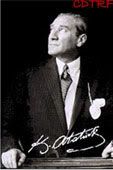Ancient stone tablets found in Turkey
Ancient stone tablets and seals unearthed during archaeological excavations at the Surtepe tumulus, in the southeastern province of Sanliurfa (Turkey), could shed light on other ancient structures discovered in the area. A team of experts headed by project director Jesus Gil Fuensanta of Spain who have been working in the area as part of the Tilbes salvage project, discovered a monumental building - believed to belong to the Persian-Achaemenid period - at the Surtepe mound during excavations in 2005. Surtepe is a large site covering 50 hectares and is believed to have been an area of settlement even during the Late Chalcolithic and Early Bronze ages (fourth and third millennia BCE).
Fuensanta explained in a statement that the Persian building "was found in a place formerly uncovered by villagers. It had an official use until the early fourth century BCE. Up to three meters of its massive mud-brick walls were preserved, and it has traces of a paved court. During the 2005 excavations, different rooms of the building were also excavated. On the inside, which was partly burnt, were typical Achaemenid pots and fragments and administrative artifacts."
Among the finds in the site are a royal glass seal in the Achaemenid style that had been disfigured by fire and depicts a fertility scene with a leader praying, said Fuensanta. Another impression on a jar shows a typical iconograph of royal worship. According to Herbert Sauren, a German specialist in ancient Semitic languages, one of the seals has official Aramaic (the administrative language of the Achaemenids) writing and refers to the capacity of a vessel.
Fuensanta believes that an enigmatic finding from the same archaeological season, a stone tablet with an inscription, could be associated with the Persian building. According to a preliminary study by Sauren the inscription on the find was made in Semitic, in use around the middle of first millennium BCE. After Sauren's translation and interpretation, it was discovered that the stone document was issued by the leader of this city (Surtepe, the ancient name of which is not yet clear) to thank a deity for his assumption of power. Separately, assistant team leader Eduardo Crivelli noticed that the few animal bones found at the site mostly belonged to horses, the statement said. The horse was a regular theme in Persian iconography of the period, it added.
The results of the studies have been presented at the 28th International Congress on Excavations, Surveys and Research in Turkey.
http://www.stonepages.com/news
Fuensanta explained in a statement that the Persian building "was found in a place formerly uncovered by villagers. It had an official use until the early fourth century BCE. Up to three meters of its massive mud-brick walls were preserved, and it has traces of a paved court. During the 2005 excavations, different rooms of the building were also excavated. On the inside, which was partly burnt, were typical Achaemenid pots and fragments and administrative artifacts."
Among the finds in the site are a royal glass seal in the Achaemenid style that had been disfigured by fire and depicts a fertility scene with a leader praying, said Fuensanta. Another impression on a jar shows a typical iconograph of royal worship. According to Herbert Sauren, a German specialist in ancient Semitic languages, one of the seals has official Aramaic (the administrative language of the Achaemenids) writing and refers to the capacity of a vessel.
Fuensanta believes that an enigmatic finding from the same archaeological season, a stone tablet with an inscription, could be associated with the Persian building. According to a preliminary study by Sauren the inscription on the find was made in Semitic, in use around the middle of first millennium BCE. After Sauren's translation and interpretation, it was discovered that the stone document was issued by the leader of this city (Surtepe, the ancient name of which is not yet clear) to thank a deity for his assumption of power. Separately, assistant team leader Eduardo Crivelli noticed that the few animal bones found at the site mostly belonged to horses, the statement said. The horse was a regular theme in Persian iconography of the period, it added.
The results of the studies have been presented at the 28th International Congress on Excavations, Surveys and Research in Turkey.
http://www.stonepages.com/news


0 Yorum:
Yorum Gönder
Kaydol: Kayıt Yorumları [Atom]
<< Ana Sayfa